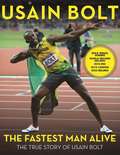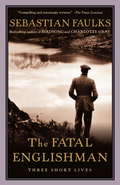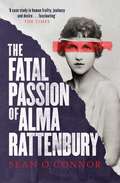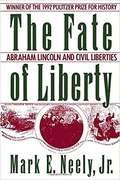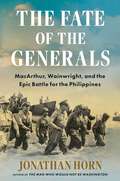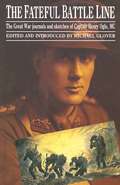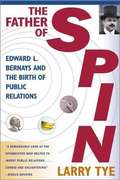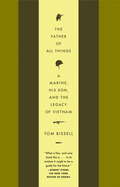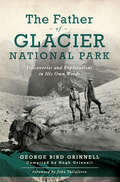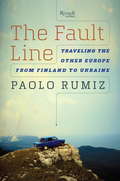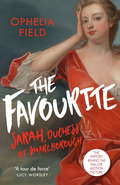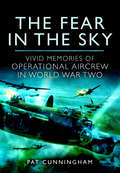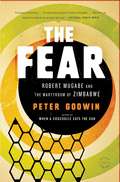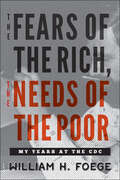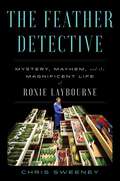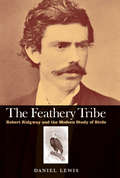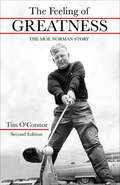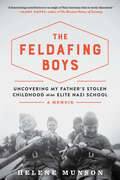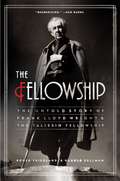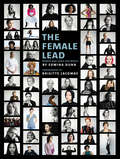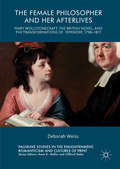- Table View
- List View
The Fastest Man Alive: The True Story of Usain Bolt
by Usain BoltA skinny kid from the Jamaican parish of Trelawny, Usain Bolt’s life changed in August 2008 when the Olympic men’s 100-meter starter pistol was followed just 9. 69 seconds later by his streak across the finish line and the first of his three gold medals was placed around his neck. In this illustrated celebration of his influences, background, and career trajectory, Bolt shares his story of growing up playing cricket and soccer, and discovering that he could run fast—very fast. He shares stories of his family, friends, and the laidback Jamaican culture, and reveals what makes him tick, where he gets his motivation, and where he takes his inspiration. He tells of the dedication and sacrifices required to get to the top, and also discusses fast food, partying, music, fast cars, and that signature lightning bolt pose.
The Fat Lady Sang
by Robert EvansFrom the legendary producer and author of The Kid Stays in the Picture—one of the greatest Hollywood memoirs ever written—comes a long-awaited second work with all the elements of a star-studded blockbuster: glamour and conflict, giddy highs and near-fatal lows, struggle and perseverance, tragedy and triumph.
The Fatal Englishman: Three Short Lives
by Sebastian FaulksIn The Fatal Englishman, his first work of nonfiction, Sebastian Faulks explores the lives of three remarkable men. Each had the seeds of greatness; each was a beacon to his generation and left something of value behind; yet each one died tragically young.Christopher Wood, only twenty-nine when he killed himself, was a painter who lived most of his short life in the beau monde of 1920s Paris, where his charm, good looks, and the dissolute life that followed them sometimes frustrated his ambition and achievement as an artist.Richard Hillary was a WWII fighter pilot who wrote a classic account of his experiences, The Last Enemy, but died in a mysterious training accident while defying doctor’s orders to stay grounded after horrific burn injuries; he was twenty-three.Jeremy Wolfenden, hailed by his contemporaries as the brightest Englishman of his generation, rejected the call of academia to become a hack journalist in Cold War Moscow. A spy, alcoholic, and open homosexual at a time when such activity was still illegal, he died at the age of thirty-one, a victim of his own recklessness and of the peculiar pressures of his time.Through the lives of these doomed young men, Faulks paints an oblique portrait of English society as it changed in the twentieth century, from the Victorian era to the modern world.
The Fatal Passion of Alma Rattenbury
by Sean O'ConnorAdultery, alcoholism, drugs and murder on the suburban streets of Bournemouth. The Rattenbury case of 1935 was one of the great tabloid sensations of the interwar period. The glamorous femme fatale at the heart of the story dominated the front pages for months, somewhere between the rise of Hitler and the launch of the Queen Mary. <p><p> With painstaking research and access to brand new evidence, Sean O’Connor vividly brings this epic story to life, from its beginnings in the South London slums of the 1880s and the open vistas of the British Columbian coast, to its bloody climax in a respectable English seaside resort. <p> The Fatal Passion of Alma Rattenbury is a gripping murder story and a heartbreaking romance as well as the biography of a vital, modern woman trapped between the freedoms of two world wars and suffocated by the conformity of peacetime. A startlingly prescient parable for our times, it is the story of a woman who dared to challenge the status quo only to be crucified by public opinion, pilloried by the press and punished by the relentless machinery of the British legal system. <p> With a wealth of fascinating period detail, from its breathtaking opening to its shocking conclusion, The Fatal Passion of Alma Rattenbury is a true story as enthralling, as provocative and as moving as any work of fiction.
The Fate of Liberty: Abraham Lincoln and Civil Liberties
by Mark E. NeelyOne of America's leading authorities on Lincoln wades straight into this controversy, showing just who was jailed and why, even as he explores the whole range of Lincoln's constitutional policies.<P><P> Pulitzer Prize Winner
The Fate of the Corps: What Became of the Lewis and Clark Explorers After the Expedition
by Larry E. Morris&“Combines adventure, mystery, and tragedy . . . a &‘Who&’s Who&’ of explorers who opened the pathway for an ocean-to-ocean America.&” —St. Joseph News-Press (Missouri) The story of the Lewis and Clark Expedition has been told many times. But what became of the thirty-three members of the Corps of Discovery once the expedition was over? The expedition ended in 1806, and the final member of the corps passed away in 1870. In the intervening decades, members of the corps witnessed the momentous events of the nation they helped to form—from the War of 1812 to the Civil War and the opening of the transcontinental railroad. Some of the expedition members went on to hold public office; two were charged with murder. Many of the explorers could not resist the call of the wild and continued to adventure forth into America&’s western frontier. Engagingly written and based on exhaustive research, The Fate of the Corps chronicles the lives of the fascinating men (and one woman) who opened the American West. &“A fascinating afterword to the expedition . . . demands inclusion in the canon of essential Lewis and Clark books.&”—Seattle Post-Intelligencer &“Succinct, clear style . . . The diverse fates of the members of the expedition . . . give the feel of a Greek epic.&”—Santa Fe New Mexican
The Fate of the Generals: MacArthur, Wainwright, and the Epic Battle for the Philippines
by Jonathan HornIn the tradition of Hampton Sides&’s bestseller Ghost Soldiers comes a World War II story of bravery, survival, and sacrifice—the vow Douglas MacArthur made to return to the Philippines and the oath his fellow general Jonathan Mayhew Wainwright made to stay with his men there whatever the cost.For the doomed stand American forces made in the Philippines at the start of World War II, two generals received their country&’s highest military award, the Medal of Honor. One was the charismatic and controversial Douglas MacArthur, whose orders forced him to leave his soldiers on the islands to starvation and surrender but whose vow to return echoed around the globe. The other was the gritty Jonathan Mayhew Wainwright, who became a hero to the troops whose fate he insisted on sharing even when it meant becoming the highest-ranking American prisoner of the Japanese. In The Fate of the Generals, bestselling author Jonathan Horn brings together the story of two men who received the same medal but found honor on very different paths. MacArthur&’s journey would require a daring escape with his wife and young child to Australia and then years of fighting over the thousands of miles needed to make it back to the Philippines, where he would fulfill his famous vow only to see the city he called home burn. Wainwright&’s journey would take him from the Philippines to Taiwan and Manchuria as his captors tortured him in prisons and left him to wonder whether his countrymen would ever understand the choice he had made to surrender for the sake of his men. A story of war made personal based on meticulous research into diaries and letters including boxes of previously unexplored papers, The Fate of the Generals is a vivid account that raises timely questions about how we define honor and how we choose our heroes, and is destined to become a classic of World War II history.
The Fateful Battle Line: The Great War Journals and Sketches of Captain Henry Ogle, MC
by Michael GloverThe diaries of front-line soldiers of the Great War are relatively commonplace; contemporary drawings and paintings, other than those by the official war artists, are less so. What is extraordinary, even unique, about The Fateful Battle Line is that it combines a journal of infantry service on the Western Front with sketches and finished work made at the time, often illustrating places, people and incident from the text. Henry Ogle was a trained artist, and one who, in his writing, fused the vividness of the painter's eye for detail with a writer's precision and awareness. Commissioned from the ranks, twice wounded, his gallantry rewarded with the Military Cross, he endured four years of war; if the experience seared him, it never took from him his humanity. Front-line, support and reserve trenches; raids, patrols and work details; outposts and piquets; hospitals and base areas; French and Belgian towns and villages; leave back home in England ; the tragic landscape of Flanders; weapons, artillery, transport, draft and riding animals; above all his fellow soldiers - Henry Ogle faithfully, and often wittily, recorded the day-to-day minutiae, as well as the sudden shattering moments, of vast industrial armies locked in the last of the great siege wars. In doing so, and in his accompanying text, he demonstrated that the enduring legacy of the Great War lay in the spirit of the men who fought it. Skillfully edited and annotated by the late Michael Glover, The Fateful Battle Line is perhaps the most remarkable and enduring original work to have come out of the First World War in the last fifty years.
The Father Of Spin: Edward L. Bernays And The Birth Of Public Relations
by Larry TyeThe Father of Spin is the first full-length biography of the legendary Edward L. Bernays, who, beginning in the 1920s, was one of the first and most successful practioners of the art of public relations. In this engrossing biography, Larry Tye uses Bernays's life as a prism to understand the evolution of the craft of public relations and how it came to play such a critical-and sometimes insidious-role in American life. Drawing on interviews with primary sources and voluminous private papers, Tye presents a fascinating and revealing portrait of the man who, more than any other, defined and personified public relations, a profession that today helps shape our political discourse and define our commercial choices.
The Father of All Things
by Tom BissellThe Father of All Things is a riveting, haunting, and often hilarious account of a veteran and his son's journey through Vietnam. As his father recounts his experiences as a soldier, including a near fatal injury, Tom Bissell weaves a larger history of the war and explores the controversies that still spark furious debate today. Blending history, memoir, and travelogue,The Father of All Things is a portrait of the war's personal, political, and cultural impact from the perspective of the generation that grew up in the wake of the conflict. It is also a wise and revelatory book about the bond between fathers and sons.
The Father of Glacier National Park: Discoveries and Explorations in His Own Words
by George Bird GrinellThe story of this glorious Montana landmark, told through the journals and letters of the man who fought to conserve it—maps and photos included. With his small group of explorers, George Bird Grinnell discovered and named forty geological features east of the Continental Divide and west of the Blackfeet Reservation. He also happened to be a prolific writer and record-keeper who diligently made time in camp for meticulous journal entries. As a result, he wrote a series of articles about his trips from 1885 to 1898 for publication in Forest and Stream. In 1891, he began advocating to protect the area as a national park—and led that charge for nearly two decades until successful. His discoveries, publications, and leadership led to the creation of Glacier National Park. In this book, his cousin Hugh Grinnell compiles first-person narratives from unpublished journal entries, personal correspondence, and dozens of articles to tell the early story of Glacier.
The Fault Line
by Gregory Conti Paolo RumizAn award-winning writer travels the eastern front of Europe, where the push/pull between old empires and new possibilities has never been more evident. Paolo Rumiz traces the path that has twice cut Europe in two--first by the Iron Curtain and then by the artificial scaffolding of the EU--moving through vibrant cities and abandoned villages, some places still gloomy under the ghost of these imposing borders, some that have sought to erase all memory of it and jump with both feet into the West (if only the West would have them). In The Fault Line, he is a sublime and lively guide through these unfamiliar landscapes, piecing together an atlas that has been erased by modern states, delighting in the discovery of communities that were once engulfed by geopolitics then all but forgotten, until now.The farther south he goes, the more he feels he is traveling not along some abandoned Eastern frontier, but right in the middle of things: Mitteleuropa wasn't to be found in Viennese cafés but much farther east, beyond even Budapest and Warsaw. As in Ukraine, these remain places in flux, where the political and cultural values of the East and West have stared each other down for centuries. Rumiz gives a human face not just to what the Cold War left behind but to the ancient ties of empire and ethnicity that are still at the root of modern politics in flash-point areas such as this.
The Favourite: The Life of Sarah Churchill and the History Behind the Major Motion Picture
by Ophelia Field'An incredible story crackling with royal passion, envy, ambition and betrayal ... Field's account of the psychological power play between Queen Anne and her confidante is surely definitive. A tour de force' Lucy WorsleySarah Churchill, Duchess of Marlborough, was as glamorous as she was controversial. Politically influential and independently powerful, she was an intimate, and then a blackmailer, of Queen Anne, accusing her of keeping lesbian favourites - including Sarah's own cousin Abigail Masham.Ophelia Field's masterly biography brings Sarah Churchill's own voice, passionate and intelligent, back to life. Here is an unforgettable portrait of a woman who cared intensely about how we would remember her - perfect for fans interested in the history behind the major motion picture starring Rachel Weisz with Olivia Colman and Emma Stone.
The Favourite: The Life of Sarah Churchill and the History Behind the Major Motion Picture
by Ophelia Field'An incredible story crackling with royal passion, envy, ambition and betrayal ... Field's account of the psychological power play between Queen Anne and her confidante is surely definitive. A tour de force' Lucy WorsleySarah Churchill, Duchess of Marlborough (1660-1774), was as glamorous as she was controversial. Politically influential and independently powerful, she was an intimate, and then a blackmailer, of Queen Anne, accusing her of keeping lesbian favourites - including Sarah's own cousin Abigail Masham.Ophelia Field's masterly biography brings Sarah Churchill's own voice, passionate and intelligent, back to life. Here is an unforgettable portrait of a woman who cared intensely about how we would remember her.
The Fear in the Sky: Vivid Memories of Bomber Aircrew in World War Two
by Pat CunninghamThe young men who flew with RAF Bomber Command in World War Two were a complex mixture of individuals but they all shared the gift of teamwork. A crew of seven may have comprised all non commissioned men and some crews included commissioned officers but not always flying as pilots. The outstanding fact was that each man relied on every other member of his crew to return from each mission safely.This book contains ten intriguing reminiscences of bomber aircrew; some were pilots, others navigators, flight engineers, bomb-aimers or gunners. They flew as both commissioned or NCO airmen..Understandably, a common problem was that of coping with fear. Many former aircrew hold that anyone who claims to have felt no fear on operations is either lying or has allowed the years to blank out that fear. But there are a few who do maintain that they never felt afraid. For the majority, though, handling fear was something to be worked out by the individual. Some hit the bottle, others womanized to excess; others tightened the gut and bit the lip; or drew the curtain and focused upon the plotting table or the wireless set.The passing years may have silvered what hair remains, dulled the eye that formerly registered on the merest speck; lent a quiver to the hand that once controlled the stick, penciled in the track, manipulated the tuning dial, set the bombsight, tapped the gauge, or rotated the turret. And yet for all the attributes of age their irrepressible youthfulness shines through.
The Fear: Robert Mugabe and the Martyrdom of Zimbabwe
by Peter GodwinJournalist Peter Godwin has covered wars. As a soldier, he's fought them. But nothing prepared him for the surreal mix of desperation and hope he encountered when he returned to Zimbabwe, his broken homeland. Godwin arrived as Robert Mugabe, the country's dictator for 30 years, has finally lost an election. Mugabe's tenure has left Zimbabwe with the world's highest rate of inflation and the shortest life span. Instead of conceding power, Mugabe launched a brutal campaign of terror against his own citizens. With foreign correspondents banned, and he himself there illegally, Godwin was one of the few observers to bear witness to this period the locals call The Fear. He saw torture bases and the burning villages but was most awed as an observer of not only simple acts of kindness but also churchmen and diplomats putting their own lives on the line to try to stop the carnage.THE FEAR is a book about the astonishing courage and resilience of a people, armed with nothing but a desire to be free, who challenged a violent dictatorship. It is also the deeply personal and ultimately uplifting story of a man trying to make sense of the country he can't recognize as home.
The Feared: Conversations with Eleven Political Prisoners
by Neeta Kolhatkar"The first night in jail is reputed to be the hardest. After that, you learn how to survive, though many prisoners carry lifelong scars." The Feared brings together interviews conducted by Neeta Kolhatkar with eleven political prisoners, and in some cases, their loved ones, in which she highlights the interviewees&’ everyday lives within the walls of multiple prisons across India. In doing so, she calls urgent attention to the grave injustices meted out to the thousands of undertrials dissent in the political life of India today. During long discussions, sometimes taking place over multiple meetings, Kolhatkar unearths personal anecdotes from the time her interviewees were incarcerated, bringing into focus the human face of prison inmates, while also detailing the wretched conditions relating to space, hygiene, medical attention, and food that they experienced. Apart from being an urgent call to action for prison reforms, The Feared is thus also an account of hope and strength, narrating unique stories of survival and solidarity, and the unexpected bonds and relationships formed in prison.
The Fears of the Rich, The Needs of the Poor: My Years at the CDC
by William W. FoegeWilliam H. Foege, one of the most respected leaders in global public health, takes readers on a tour of his time at the CDC.In its seventy years, the Centers for Disease Control and Prevention (CDC) has evolved from a malaria control program to an institution dedicated to improving health for all people across the world. The Fears of the Rich, The Needs of the Poor is a revealing account of the CDC’s development by its former director, public health luminary William H. Foege.Dr. Foege tells the stories of pivotal moments in public health, including the eradication of smallpox (made possible due in part to Foege’s research) and the discovery of Legionnaires’ disease, Reye syndrome, toxic shock syndrome, and HIV/AIDS. With good humor and optimism, he recounts the various crises he surmounted, from threats of terrorist attacks to contentious congressional hearings and funding cuts. Highlighting the people who made possible some of public health’s biggest successes, Foege outlines the work required behind the scenes and describes the occasional tensions between professionals in the field and the politicians in charge of oversight. In recent years, global public health initiatives have come from unanticipated sources. Giants in the field now include President Jimmy Carter and his wife, Rosalynn, who promote programs aimed at neglected diseases. Melinda and Bill Gates have invigorated the field through research and direct program support, especially in the area of vaccine-preventable diseases. And the Merck Mectizan program has dramatically reduced river blindness in Africa. Foege has been involved in all of these efforts, among others, and he brings to this book the knowledge and wisdom derived from a long and accomplished career. The Fears of the Rich, The Needs of the Poor is an inviting but unvarnished account of that career and offers a plethora of lessons for those interested in public health.
The Feather Detective: Mystery, Mayhem, and the Magnificent Life of Roxie Laybourne
by Chris SweeneyThe fascinating and remarkable true story of the world&’s first forensic ornithologist—Roxie Laybourne, who broke down barriers for women, solved murders, and investigated deadly airplane crashes with nothing more than a microscope and a few fragments of feathers.In 1960, an Eastern Airlines flight had no sooner lifted from the runway at Boston Logan Airport when it struck a flock of birds and took a nosedive into the shallow waters of the Boston Harbor, killing sixty-two people. This was the golden age of commercial airflight—luxury in the skies—and safety was essential to the precarious future of air travel. So the FAA instructed the bird remains be sent to the Smithsonian Institution for examination, where they would land on the desk of the only person in the world equipped to make sense of it all. Her name was Roxie Laybourne, a diminutive but singular woman with thick glasses, a heavy Carolina drawl, and a passion for birds. Roxie didn&’t know it at the time, but that box full of dead birds marked the start of a remarkable scientific journey. She became the world&’s first forensic ornithologist, investigating a range of crimes and calamites on behalf of the FBI, the US Air Force, and even NASA. The Feather Detective takes readers deep within the vaunted backrooms of the Smithsonian&’s National Museum of Natural History to tell the story of a burgeoning science and the enigmatic woman who pioneered it. While her male colleagues in taxidermy embarked on expeditions around the world and got plum promotions, Roxie stayed with her birds. Using nothing more than her microscope and bits of feathers, she helped prosecute murderers, kidnappers, and poachers. When she wasn&’t testifying in court or studying evidence from capital crimes, she was helping aerospace engineers and Air Force crews as they raced to bird-proof their airplanes before disaster struck again. In The Feather Detective, award-winning journalist Chris Sweeney charts the astonishing life and work of this overlooked pioneer. Once divorced, once widowed, and sometimes surly, Roxie shattered stereotypes and pushed boundaries. Her story is one of persistence and grit, obsession and ingenuity. Drawing on reams of archival material, court documents, and exclusive interviews, Sweeney delivers a moving and amusing portrait of a woman who overcame cultural and scientific obstacles at every turn, forever changing our understanding of birds—and the feathers they leave behind.
The Feathery Tribe
by Daniel LewisAmateurs and professionals studying birds at the end of the nineteenth century were a contentious, passionate group with goals that intersected, collided and occasionally merged in their writings and organizations. Driven by a desire to advance science, as well as by ego, pride, honor, insecurity, religion and other clashing sensibilities, they struggled to absorb the implications of evolution after Darwin. In the process, they dramatically reshaped the study of birds. Daniel Lewis here explores the professionalization of ornithology through one of its key figures: Robert Ridgway, the Smithsonian Institution’s first curator of birds and one of North America’s most important natural scientists. Exploring a world in which the uses of language, classification and accountability between amateurs and professionals played essential roles, Lewis offers a vivid introduction to Ridgway and shows how his work fundamentally influenced the direction of American and international ornithology. He explores the inner workings of the Smithsonian and the role of collectors working in the field and reveals previously unknown details of the ornithological journalThe Aukand the untold story of the color dictionaries for which Ridgway is known.
The Feeling of Greatness: The Moe Norman Story
by Tim O'ConnorFrom the award-winning journalist and coach: a biography of “the ‘Rain Man’ of golf. It’s a character drama. It’s an underdog story” (Barry Morrow, Academy Award–winning screenwriter).Documentary now in production!In The Feeling of Greatness, second edition, golf coach Tim O’Connor updates his previous biography of the late great, Canadian golfer Moe Norman, who was famous for introducing the single plane golf swing. This edition includes new anecdotes about Moe both on and off the course by golfers, journalists, friends, and family, and offers a more in-depth portrait of the man and golfer, especially in the last years of his life. O’Connor shares with readers his personal and professional friendships with Moe along the way. Some twenty years later, from a distanced perspective, O’Connor sets the record straight about Norman, promotes his legacy as the legendary golfer he was, and reflects on life lessons learned from their association over the years.Praise for Moe Norman and The Feeling of Greatness“Only two players have ever owned their swings: Moe Norman and Ben Hogan.” —Tiger Woods“Well-written and meticulously researched.” —James McCarten, PGATour.com“Tim O’Connor has helped us better understand one of golf’s most intriguing and disturbing members.” —Hal Quinn, The Financial Post
The Feldafing Boys: How My Father's Generation Was Trained To Kill And Sent To Die For Germany
by Helene MunsonA shocking personal memoir and new perspective on World War II, following Helene Munson’s journey in her father’s footsteps through the years when he was one of Hitler’s child soldiers When Helene Munson finally reads her father, Hans Dunker’s, wartime journal, she discovers secrets he kept buried for seven decades. This is no ordinary historical document but a personal account of devastating trauma. During World War II, the Nazis trained some three hundred thousand German children to fight for Hitler. Hans was just one of those boy soldiers. Sent to the elite Feldafing school at nine years old, he found himself in the grip of a system that substituted dummy grenades for Frisbees. By age seventeen, Hans had shot down Allied pilots with antiaircraft artillery. In the desperate, final stage of Hitler’s war, he was sent on a suicide mission to Závada on the Sudetenland front, where he witnessed the death of his schoolmates—and where Helene begins to retrace her father’s footsteps after his death. As Helene translates Hans’s journal and walks his path of suffering and redemption, she uncovers the lost history of an entire generation brainwashed by the Third Reich’s school system and funneled into the Hitler Youth. A startling new account of this dark era, The Feldafing Boys grapples with inherited trauma, the burden of guilt, and the blurred line between “perpetrator” and “victim.” It is also a poignant tale of forgiveness, as Helene comes to see her late father as not just a soldier but as one boy in a sea of three hundred thousand forced onto the wrong side of history—and left to answer for it. Previously published in hardcover as Hitler’s Boy Soldiers
The Fellowship: The Untold Story of Frank Lloyd Wright & the Taliesin Fellowship
by Harold Zellman Roger Friedland“Compelling.” — Kirkus Reviews“The Fellowship both fascinates and infuriates. You can’t top the material for richness: genius, sex, spirituality, madness, money, mania.” — USA Today“[A] blockbuster…packed [with] plenty of sex and surprises. …This book has a lot of news.” — Capital Times“A mesmerizing account of the drama that compelled the great architect…to greater accomplishments…and the cost of that success.” — Ken Burns, award-winning director of The Civil War, Jazz, and Frank Lloyd Wright“Authoritative and eminently readable…uncover[s] the sometimes strange, sometimes scandalous, always tumultuous atmosphere in which Wright created his pioneering designs.” — Robert C. Twombly, author of Frank Lloyd Wright: His Life and His Architecture“This book replaces Wright the demigod with Wright the man…[A] new—and truer—picture of Frank Lloyd Wright.” — Alan Hess, author of Frank Lloyd Wright: The Houses“Sheds light on the forgotten men and women who played so important a role in bringing…[Wright’s] conceptions to reality.” — Franklin Toker, author of Fallingwater Rising“Fascinating…good history. And a ripping read.” — Architect's Newspaper“An extraordinary and disquieting tale...that captures the strange, shadowy and all-too-human world that can gather around genius.” — Mark Stevens, Pulitzer Prize-winning author of de Kooning“First to treat the Taliesin Fellowship as a whole — its origin, its workings and its inner life.” — Wall Street Journal“Just when you thought there was nothing new to be learned about the great American architect Frank Lloyd Wright, a massive, gossipy and yet compulsively readable new book proves you wrong. . . .Friedland and Zellman break new ground with dozens of firsthand interviews that illuminate the crucial role of the apprentices—and of his regl last wife, Olgivanna—in shaping the second half of the architect’s storied and controversial career.” — Chicago Sun-Times
The Female Philosopher and Her Afterlives
by Deborah WeissThis book argues that the female philosopher, a literary figure brought into existence by Mary Wollstonecraft's A Vindication of the Rights of Woman, embodied the transformations of feminist thought during the transition from the Enlightenment to the Romantic period. By imagining a series of alternate lives and afterlives for the female philosopher, women authors of the early Romantic period used the resources of the novel to evaluate Wollstonecraft's ideas and legacy. This book examines how these writers' opinions converged on such issues as progress, education, and ungendered virtues, and how they diverged on a fundamental question connected to Wollstonecraft's life and feminist thought: whether the enlightened, intellectual woman should live according to her own principles, or sacrifice moral autonomy in the interest of pragmatic accommodation to societal expectations.
